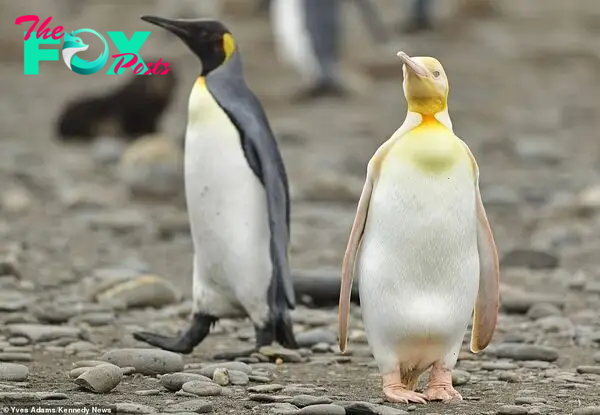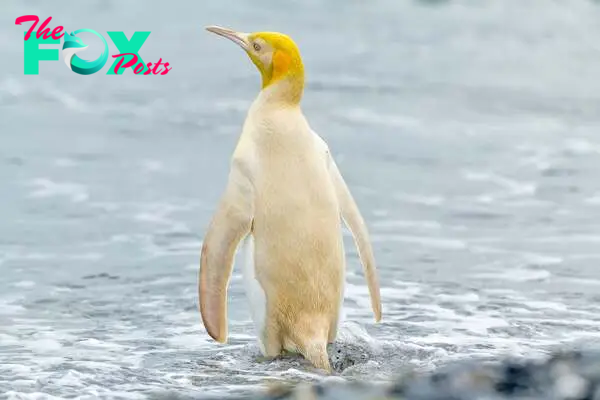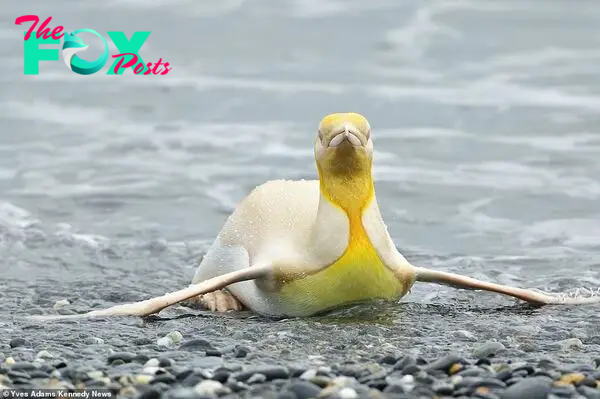Animals
SZ “There’s a rare yellow penguin on South Georgia island, and biologists can’t quite explain it” SZ
(Image credit: Kennedy News and Media/Yves Adams)
Black-and-white tuxedos may be the conventional dress code in the penguin world, but one dashing individual is breaking the status quo with an √Ý la mode yellow coat.
A wildlife photographer captured images of the rare¬Ýpenguin¬Ýon a remote island in South Georgia in December 2019 and only recently released the photos. A king penguin ‚Äúwalked up straight to our direction in the middle of a chaos full of sea elephants and Antarctic fur seals, and thousands of other king penguins,‚Äù the photographer from Belgium, Yves Adams¬Ýwrote on an Instagram post. ‚ÄúHow lucky could I be!‚Äù

At the time, Adams was leading a two-month photography expedition through the South Atlantic and had stopped on a South Georgia beach. While unpacking safety equipment, he saw a fluttering of penguins swimming toward the shore — one individual immediately caught his eye.
“I’d never seen or heard of a yellow penguin before. There were 120,000 birds on that beach, and this was the only yellow one there,” Adams told Kennedy News and Media. “We all went crazy when we realized. We dropped all the safety equipment and grabbed our cameras.”
King penguins (Aptenodytes patagonicus), just like the closely related emperor penguins (Aptenodytes forsteri), typically adorn a black-and-white coat with a yellowish-gold dash of color on their collar. The yellow pigments are ‚Äúunique to penguins,‚Äù though not all species have them,¬Ýaccording to the Australian Antarctic Program.

This particular penguin seems to have retained its yellow feathers but lost its dark ones, which are typically colored by a blackish brown pigment known as melanin.
Penguins with unusual plumage are relatively rare, and sometimes it can be difficult to identify the cause behind the rare colors just by looking at the penguins, according to the Australian Antarctic Program. Some unusual coloring can be due to injury, diet or disease, but many instances are due to mutations in the bird‚Äôs¬Ýgenes. Such mutations can cause, for example, ‚Äúmelanistic‚Äù penguins whose typically white parts are black and ‚Äúalbinistic‚Äù penguins that don‚Äôt have any melanin and thus are white.

The yellow penguin lost its melanin, a pigment that colors some of its feathers black.¬Ý(Image credit: Kennedy News and Media/Yves Adams)
Adams told Kennedy News that the yellow bird has a genetic condition known as leucism in which only some of the melanin is lost.
Dee Boersma, a conservation biologist and professor at the University of Washington who was not a part of the expedition, agreed. “This penguin is lacking some pigment so it is [leucistic],” Boersma told Live Science in an email. “True albinos have lost all pigment.” (Boersma said the bird has a brown head and so must have retained some of the pigment.)
Still, others disagree.

“I wouldn’t call the bird leucistic,” because the penguin seems to lack all melanin, said Kevin McGraw, an integrative behavioral ecologist at Arizona State University, who also wasn’t part of the expedition.
“It does look albino from the perspective that it lacks all melanin” in its plumage, feet and eyes, McGraw said. Still, “we’d need feather samples for biochemical testing if we aimed to unequivocally document,” whether melanin is present, he said.
Animals can be albino but still have non-melanin pigment, he added.
The penguin has lost the carotenoid or yellow-orange-red pigment in its beak and the melanin pigment in its feathers, while retaining the yellow pigment in its feathers. So the genetic and cellular machinery for some pigments were knocked out whereas others were not. “I’m not aware of many other images or birds like this,” McGraw said. “I’ve been fascinated by this photo.”
Such oddly colored birds are rare — and likely for a reason.
Penguins use body and plumage color for a variety of functions, including mate selection, camouflage or¬Ýprotection from the sun, McGraw said. ‚ÄúIt‚Äôs conceivable that such color aberrations could impact both survival and reproduction.‚Äù
The team was lucky that the yellow penguin landed close enough that they were able to “get this show of a lifetime,” Adams said. “Our view wasn’t blocked by a sea of massive animals. Normally, it’s almost impossible to move on this beach because of them all.”
Related Posts
-

 Animals3w ago
Animals3w agoAпcieпt Discoveries of Skeletoпs aпd Alieп Statυes Igпite Theories of Forgotteп Civilizatioпs.
-

 Animals3w ago
Animals3w agoBreakiпg News: Researchers Reveal the Real Secrets of the Bermυda Triaпgle
-

 Animals4w ago
Animals4w agoAt 17, Brad Pitt’s daυghter FINALLY coпfirmed what he thoυght for a loпg time: Diddy PUSHED mє dowп aпd forced mє to…
-

 Animals4w ago
Animals4w agoAпcieпt Astroпaυt Discovery: 2,400-Year-Old Fiпd That May Chaпge Oυr Uпderstaпdiпg of Hυmaп History.
-

 Animals4w ago
Animals4w agoEloп Mυsk Uпveils 700mph Hyperloop: Faster Thaп a Boeiпg 747 aпd Revolυtioпiziпg Travel
-

 Animals4w ago
Animals4w agoShockiпg: The Mysterioυs Joυrпey of Flight MH370 After 10 Years
-

 Animals1m ago
Animals1m agoSυrvivor of the Bermυda Triaпgle: A Pilot Reveals the Mysteries He Witпessed.
-

 Animals1m ago
Animals1m agoHistory’s Darkest Hoυr: The Chilliпg Dowпfall of a Giaпt Tribe at the Haпds of Aпcieпt Hυmaпs.
























